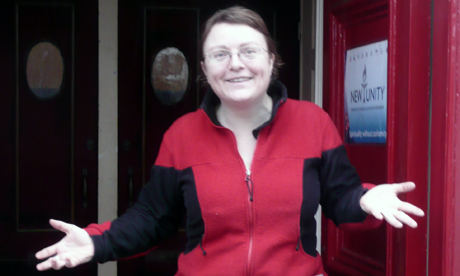Mary Wollstonecraft – a statue of her own

Showing the way: Roberta Wedge
I’ve always been a bit suspicious of die-hard fans. How comforting it must be to believe in something so strongly, without questions or nagging doubts. Being a sports fan, for instance, has to be one of the easiest things in the world. Season after season, and nothing really changes. All you can be sure of is that someone wins and someone else loses.
Not that Roberta Wedge is the kind of woman to be swept up by the fervour of a crowd or to follow unthinkingly. I first became aware of the 43-year-old former English teacher through her work for Mary on the Green, a campaign to raise funds for a statue on Newington Green of Mary Wollstonecraft, the eighteenth-century author, philosopher and champion of women’s rights.
Mary Wollstonecraft is best known for writing A Vindication of the Rights of Woman (1792), a key feminist treatise arguing that women seem inferior to men only because they lack education. In a short life she ran a boarding school for girls, wrote novels, a travel narrative and a history of the French Revolution.
She was also the mother of Mary Shelley, writer of Frankenstein, dying ten days after her birth, aged 38. “I always say to people, if you were raised by a woman who could read and vote and work then you owe something to Mary Wollstonecraft,” says Wedge. “And that is true for men or women, because most of us are raised by women.”
On most Sunday mornings, Roberta Wedge can be found occupying the old Wollstonecraft family pew in the Unitarian church on Newington Green. She never used to be religious, but in 2009, the year marking 250 years since Mary Wollstonecraft’s birth, she noticed a banner outside proclaiming it ‘the birthplace of feminism’.
Her interest piqued, she went inside. “I said to myself, ‘get over your stupid prejudices,’ and went in. There was a service and in the announcements afterwards someone said, ‘We’re preparing for the anniversary of Mary Wollstonecraft, and we have all these activities planned.’ And I was like, ‘Wow, they’re celebrating Mary Wollstonecraft!’ So I went back and ended up promoting the activities they had lined up.”
Wedge keeps a Wollstonecraft-themed blog, and even tweets as her, complete with 18th-century diction. She says, “The idea of my blog is to compile information about all Wollstonecraft projects going on worldwide. It’s really satisfying when I get a French philosopher in Turkey who’s got a book coming out on Mary next year and a Japanese historian in Japan who also has a book coming out on her and I put them in touch with each other.”
The conversation veers from her lamenting the lack of Mary Wollstonecraft merchandise (apparently it’s due to there being only two portraits of her), to Wedge’s ultimate dream of making a Hollywood blockbuster about her life. “Many of her characteristics appeal to me,” she says. “Mary Wollstonecraft reinvented her life time after time. When the school she founded in Newington Green went bankrupt she set herself up as a writer and became the first woman to earn her living writing.”
Perhaps more realistically, Wedge would like to create a Mary Wollstonecraft society. “It does seem rather odd that there isn’t one,” she says. “There’s some that thrive: the Jane Austen society, for example. And in the Sherlock Holmes society members dress up in deer stalker hats, take trains to Switzerland and go to the waterfall where he fell off. Mary has nothing, and why is this?”
It’s one of the recurring themes of our conversation, how Mary Wollstonecraft is continually overlooked and doesn’t get the recognition she deserves. “When I mention her name a very good number have never heard of her,” she laments. “And another fraction say, ‘Oh, didn’t she write Frankenstein?'”
She takes out her wallet and shows me a commemorative stamp, issued to mark the 250th anniversary three years ago. “It was six months late because they kind of forgot, and when they did make one of her, it was in a list of ten and maybe nine were really obscure people. So you couldn’t even buy a sheet of Mary Wollstonecraft!”
All that may change if the statue goes ahead. On a cold November night last year, Wedge was among a small gathering watching a projection of Mary Wollstonecraft beamed across the Thames onto the Houses of Parliament. It was the campaign’s latest fundraising push. “I think it is entirely legitimate to attempt to people our visual landscape with things to look at and touch which connect us to our history and help us look up to the future,” Wedge says.
She confides that her vision is for a statue of Mary Wollstonecaft with a niche people can leave books in. It could yet happen. If it does, and in the next 50 years the focal point of Newington Green is a statue of its most famous resident, it’ll be in no small part thanks to Roberta Wedge’s extraordinary energy and enthusiasm.

we are ready to support this 100%
feminism whats the point ?
Cock&balls (and nothing else undoubtedly), if you were a girl in Afghanistan wanting something as basic as an education or a job & was receiving death threats because of it, you wouldn’t be asking that moronic question. Education & the freedom to exercise its results arecobviously wasted on you. And Roberta, it also demonstrates exactly why a statue of Mary is a brilliant idea. Right behind you.
Great that Newington Green Action Group’s Mary Wollstonecraft memorial project is gathering more support!
If you would like to fund-raise or make a donation, visit the Mary on the Green website.